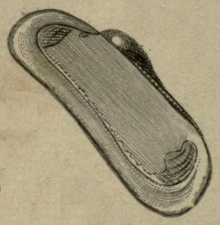
Bivalvia, in previous centuries referred to as the Lamellibranchiata and Pelecypoda, is a class of marine and freshwater molluscs that have laterally compressed bodies enclosed by a shell consisting of two hinged parts. As a group, bivalves have no head and they lack some usual molluscan organs, like the radula and the odontophore. The class includes the clams, oysters, cockles, mussels, scallops, and numerous other families that live in saltwater, as well as a number of families that live in freshwater. The majority are filter feeders. The gills have evolved into ctenidia, specialised organs for feeding and breathing. Most bivalves bury themselves in sediment, where they are relatively safe from predation. Others lie on the sea floor or attach themselves to rocks or other hard surfaces. Some bivalves, such as the scallops and file shells, can swim. The shipworms bore into wood, clay, or stone and live inside these substances.

The Arcida is an extant order of bivalve molluscs. This order dates back to the lower Ordovician period. They are distinguished from related groups, such as the mussels, by having a straight hinge to the shells, and the adductor muscles being of equal size. The duplivincular ligament, taxodont dentition, and a shell microstructure consisting of the outer crossed lamellar and inner complex crossed lamellar layers are defining characters of this order.
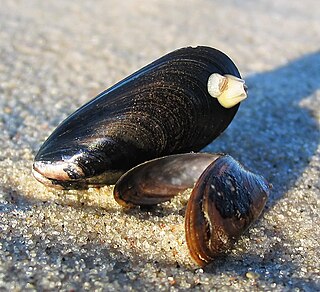
Mytilidae are a family of small to large marine and brackish-water bivalve molluscs in the order Mytilida. One of the genera, Limnoperna, even inhabits freshwater environments. Mytilidae, which contains some 52 genera, is the only extant family within the order Mytilida.
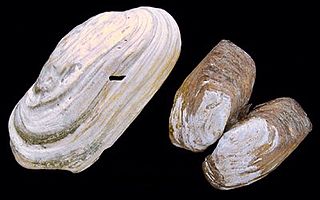
Hiatella arctica, known as the wrinkled rock-borer, the arctic hiatella or the arctic saxicave, is a species of saltwater clam, a marine bivalve mollusc in the family Hiatellidae. The white shell of this mollusc is thick and more or less rectangular, but generally irregular in shape. It is up to 45 mm long.

Amphibalanus improvisus, the bay barnacle, European acorn barnacle, is a species of acorn barnacle in the family Balanidae.
Adipicola is a genus of saltwater clams, marine bivalve molluscs in the family Mytilidae, the mussels.
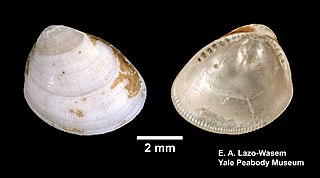
Nucula proxima, commonly known as the Atlantic nut clam, is a marine bivalve mollusc in the family Nuculidae. It can be found along the Atlantic coast of North America, ranging from Nova Scotia to Texas, including Bermuda.

Isognomon radiatus, the radial purse oyster or Lister's tree oyster, is a species of bivalve mollusc in the family Isognomonidae. It can be found along the Atlantic coast of North America, ranging from southern Florida to Brazil and Bermuda.

Kalolophus speciosus, or Gibbs' clam, is a species of bivalve mollusc in the family Crassatellidae. It can be found along the Atlantic coast of North America, ranging from North Carolina to the West Indies.
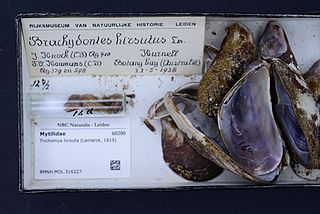
Trichomya is a monotypic genus of marine bivalve molluscs in the family Mytilidae, the mussels. The only species is Trichomya hirsuta which is endemic to southern and eastern Australia. Its common names include the hairy mussel, the greenling and the kelp greenling.

Ophiura albida is a species of brittle star in the order Ophiurida. It is typically found on the seabed in the north eastern Atlantic Ocean and in the Mediterranean Sea and is sometimes known as the serpent's table brittle star.
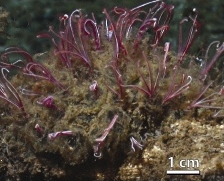
Osedax frankpressi is a species of bathypelagic polychaete worm that lives on the seabed and sustains itself on the bones of dead whales. It can be found in the East North Pacific Ocean. The specific epithet is named in honor of Frank Press "for his distinguished service to science".
Amathia verticillata, commonly known as the spaghetti bryozoan, is a species of colonial bryozoans with a bush-like structure. It is found in shallow temperate and warm waters in the western Atlantic Ocean and the Caribbean Sea and has spread worldwide as a fouling organism. It is regarded as an invasive species in some countries.

Marthasterias is a genus of starfish in the family Asteriidae. It is monotypic and the only species in the genus is Marthasterias glacialis, commonly known as the spiny starfish. It is native to the eastern Atlantic Ocean.

Pinna rudis, the rough pen shell or spiny fan-mussel, is a species of bivalve mollusc in the family Pinnidae. It is the type species of the genus Pinna. Knowledge about this is sparse, with an absence of specific studies and literature.
Phoronis ovalis is a species of marine horseshoe worm in the phylum Phoronida. It is found in shallow waters in the northeastern Atlantic Ocean, the southeastern Atlantic Ocean, Argentina, and other scattered locations worldwide. These worms secrete a tube into which they can retreat, and burrow into the shells of molluscs.

Modiolus barbatus, the bearded horse mussel, is a species of "horse mussel", a marine bivalve mollusc in the family Mytilidae, the mussels.

Modiolus capax, common name fat horsemussel, is a species of "horse mussel", a marine bivalve mollusc in the family Mytilidae, the mussels. It was first described to science by American malacologist Timothy Abbott Conrad in 1837. The type specimen was collected in San Diego by Thomas Nuttall.

Glycymeris yessoensis is a species of bivalve mollusc in the family Glycymerididae. It can be found burrowing in soft sediment in shallow water in the Pacific Ocean around the coasts of China and Japan. It is often associated with a polychaete worm with which it forms a commensal relationship.

Idas simpsoni, previously known as Adipicola simpsoni, is a species of saltwater clam, a marine bivalve mollusc in the family Mytilidae, the mussels. It is a deepwater species and is only found attached to the bones of dead whales.
